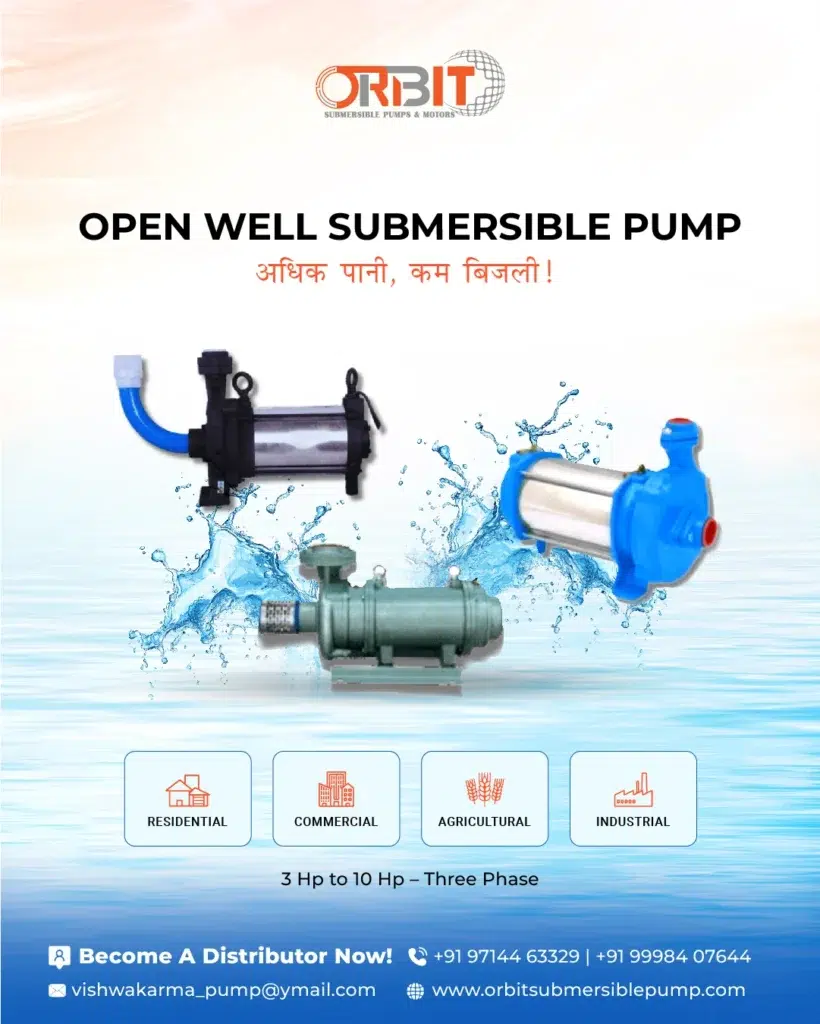7 Open Well Submersible Pump Troubleshooting Tips Everyone Should Know

If you are reading this, chances are your open well submersible pump has stopped working as effectively as it should have been doing. Maybe the water flow has reduced; maybe the motor is making strange noises, or cannot be started at all. Don’t worry! You are not alone.
In this blog, we’ll discuss 7 of the most common open well submersible pump problems and tell you what you can do to make them great again by providing you with a few simple tips. Consider this your step-by-step troubleshooting guide and easy-to-understand common sense.
What is an Open Well Submersible Pump?
But before we start solving these problems, let’s get to the machine we are dealing with. An open well submersible pump is installed directly inside a well and stays underwater. Since it is always in the water, it doesn’t require the same priming as conventional pumps and is often more efficient.
In India, such pumps are widely used for agriculture, household water supply and small-scale industries. But like all tools, they suffer wear and tear, power supply problems and, on occasion, simple misuse.
7 Troubleshooting Tips for Open Well Submersible Pump Problems
Let’s get straight down to it now. Here are the 7 troubleshooting tips that everyone needs to know:
1. Test the Power Supply and Motor Leads
A faulty power supply is the most common cause of a pump not working. Sometimes, it’s a loose wire, a tripped MCB (miniature circuit breaker), or low voltage in your area.
What to do:
- Ensure the power source is stable.
- Inspect connections and fuses.
- If the motor still doesn’t run, then it may be time to call an electrician.
2. Fix Low Water Flow Issues
Is your pump running but water stopped appearing as forcefully? That usually means clogging. Obstructions of the impeller (with dirt, sand or small stones for example) can also restrict the flow.
What to do:
- Turn off the pump and allow it to cool.
- Clear the pump’s strainer and impeller.
- Make certain your well water is maintained at an adequate level.
- If your pump is running and there’s no water coming out, this may be the issue.
3. Check for Air Locks & Priming Problems
Yes, even submersibles can become air locked. As soon as air is held within it, water does not flow.
What to do:
- Switch off the pump and switch it on again after a couple of minutes.
- Inspect your pipelines for leaks that might be allowing air inside.
- Check that the suction pipe (if fitted) is correctly immersed.
4. Check for Overheating or Burnt Motor
If that motor smells burnt, hums or trips constantly, it’s probably overheating. Reasons may be voltage variation, dry-running (working without water) or internal coil burn out.
What to do:
- Do not operate the pump when the water level is too low.
- Use a quality starter with overload protection.
- If the overheating of the motor continues, consult with a technician right away.
5. Inspect the Seals, Bearings and Impellers on Your Pump
As time goes on, mechanical parts such as seals, bearings and impellers wear down. This can result in noisy operation, leakage, or reduced performance.
What to do:
- Listen for harsh sounds (grinding, rattling).
- Check for visible leaks.
- Replace worn-out parts. Yes, a submersible pump is repairable.
6. Keep Pump Clean & Maintain Regularly
As with any machine, prevention is better than cure. By cleaning your equipment on a regular basis and performing proper maintenance you can prevent those untimely breakdowns.
What to do:
- Remove debris around the pump.
- Check electrical connections monthly.
- Have the pump professionally serviced at least once a year.
7. When to Call in the Professionals?
DIY repairs are good fun, but sometimes you need expert hands. If your water pump has had several motor failures, electrical burns or serious mechanical problems, don’t risk any more damage.
What to do:
- Hire a local trained professional.
- If the pump is much older and needs constant repair, it may be better replaced with new open well submersible pumps for cost-effective performance.
FAQs About Open Well Submersible Pump
Q1. What are the most common problems with submersible well pumps?
A: Low water flow, motor doesn’t start at all, overheating, air locks and wear and tear (bearings/seals).
Q2. What are the symptoms of a submersible well pump failure?
A: Smell of burning, frequent tripping, strange noises, no water pumping or inefficiency.
Q3. Why is my submersible well pump running but not pumping water?
A: Air lock, blocked or clogged impeller, or very low water levels in the well.
Q4. Is a submersible pump repairable?
A: Yes! Many issues like motor rewinding, bearing replacement, and seal repairs can extend the life of your pump.
Q5. How to maintain a submersible well pump?
A: Clean frequently, don’t dry run the pump, service it at least once a year and always use a good quality starter.
Conclusion
Your open well submersible pump is a lifesaver for farming, domestic or industrial use. Problems are inevitable and still, most of them are fixable with simple troubleshooting steps.
Remember:
- Start with basic inspections (power, wiring, cleaning).
- Don’t ignore small issues, They can grow into costly repairs.
- When in doubt, call a professional.
At Orbit Submersible Pumps we make sure that your pumps are built to last with maximum efficiency and minimum maintenance. If you’re looking for a reliable pump or want expert advice, Check out our range of open well submersible pumps in India.
Keep your pump healthy, and it will keep your water flowing!

